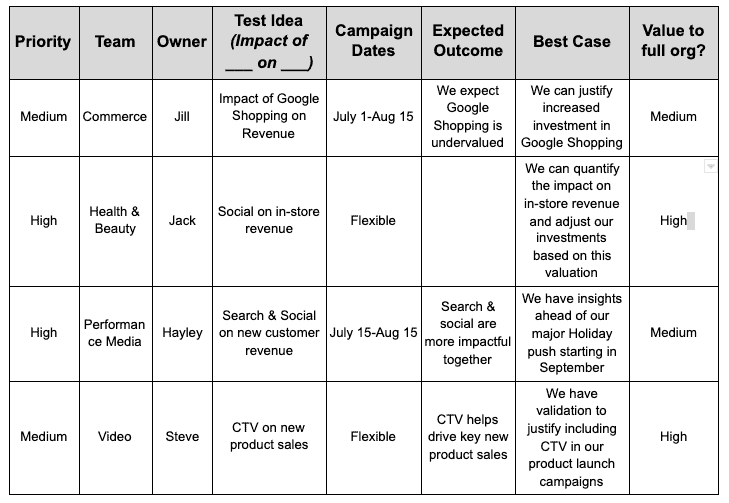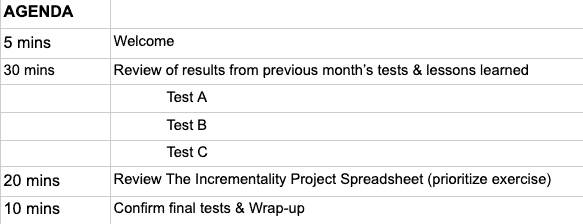
Moti Radomski
VP, Product @ Skai

Moti Radomski
VP, Product @ Skai

In working with our partners, one of the things we’ve learned is that the difference between a successful transition to an incrementality measurement practice, and repeated struggles, often lies in their internal processes rather than any particular analytical brilliance.
As I explained in my first post on this topic, incrementality requires marketers to come up with things to test, and I shared some of the kinds of questions incrementality can answer. Like anything else, building an incrementality measurement practice is about the habits you and your teams develop over time. It’s a new way of thinking that everyone will need to get comfortable with, and requires a shift to a proactive approach to measurement. It might feel a little weird at first, but done right, your incrementality program could become a defining competitive advantage for your business, and allow you and your team to make a real difference in the top and bottom line.
Today, I want to share how successful companies are making the switch from multi-touch attribution with a few pieces in place to help facilitate a best-in-class incrementality measurement practice:
The test and control approach of incrementality is material here because it means that marketers have to be very discerning about how they prioritize their tests.
It’s analogous to why chemists don’t test 20 different compounds on each other at the same time—they test Chemical A with Chemical B first and then once those tests are concluded, they test Chemical A with Chemical C…and so on. This means that only a limited number of tests can be run at the same time. Tests also take time—a minimum of 2-3 weeks. So, although the organization may have a giant list of things they want to measure, that list needs to be prioritized.
Because the key to incrementality is figuring out which tests to run, it’s important to keep a list of every measurement question that might need answering. This should be a public spreadsheet for any marketing team members to add new ideas and provide a rationale for why their test is important. Even non-marketing folks could be included as part of the brainstorming.
Here’s an example of what this document might look like in your organization:

the project tracker doc enables anyone on your team to submit measurement tests
You never know where a great idea can come from, so even a junior marketer may have something to contribute. As with any brainstorming process, the goal is to capture every idea and edit it all later.
Most marketing organizations will have a pretty long list of things they want to test with incrementality and each team may have its own set of very specific tests on their list.
How does a marketing team figure out where to start?
After seeing numerous ways that brands have adopted incrementality, Skai’s best practice recommendation is for marketers to build a cross-functional team that meets regularly to prioritize and re-prioritize the list of desired incrementality tests. This team should include at least one member from each channel—ideally, an experienced practitioner if not the most senior channel marketer available. With each test taking 2-3 weeks to complete and, the optimal cadence for new incrementality tests seems to be monthly. This allows for a short setup/ramp-up period at the front end of each test and time to analyze and study each test’s results.
The incrementality team meeting should begin with an overview of the previous month’s tests because those results may prompt new ideas for tests or change the priority level of tests already on the list. A discussion should follow in which team members debate the merits of each test—especially the ones marked to be most impactful to the entire marketing organization.
Here’s an example of what an agenda of an hour-long monthly measurement meeting may look like:

what your monthly incrementality measurement practice meeting might look like
By the end of this meeting, the list of tests should be locked in by prioritization level and the next three incrementality tests identified. For every test planned, there should be a clear agreement on what the test is trying to achieve and the expected results for review against the actual outcome in the next meeting. This “give and take” can often be hard—and sometimes contentious—after all, great marketers know that accurate measurement is the key to driving marketing ROI, so there will certainly be different opinions on how to proceed. This is why this team also needs a key stakeholder at the top that can mitigate roadblocks and make final calls if the team is split.
It makes sense to record these meetings and save them in case there’s a need to go back and review the initial thinking behind a specific test.
Incrementality uses the same test & control experimentation methodology we all learned in elementary school; a Test group is exposed to a marketing channel/tactic and a Control group isn’t in order to determine the impact of the marketing element being tested. Those groups can be split geographically or via audience segmentation, but with new consumer data tracking limitations, it’s getting harder to properly regulate an audience segmentation test, so geographic splits are becoming the standard approach.
Running incrementality tests used to be complex, slow, and expensive. However, new innovations in Artificial Intelligence and machine learning have made it much easier, faster, and cost-effective than ever before.
Skai’s Impact Navigator platform helps marketers to:
Design cross-channel incrementality experiments that meet their needs. Impact Navigator can measure most any channel or business KPI, allowing marketers to measure the impact of current strategies, validate new ones, and even explore beyond media tactics (ever wonder if your promotions are cannibalizing existing sales?). At the same time, the Impact Navigator platform empowers you to pick the test design that best fits your need for each specific test.
Scale up their marketing programs with confidence. Not only can you validate that your marketing investments are helping grow your business, with Impact Navigator you can identify the optimal level of investment, and identify areas to further optimize your strategies to maximize your impact.
Get to insight and make decisions faster. Go from idea to results and decisions in weeks rather than months.
Expand their incrementality programs while shifting valuable data sciences to other high priority projects.
Navigate data deprecation and the complicated post-cookie world. Impact Navigator’s geo-based methodology allows you to measure on and offline investments and KPIs without the need for user tracking or personally identifiable information of any kind. With Impact Navigator marketers can get answers while respecting their customer’s desire for privacy.
The final piece of the puzzle is to circulate the results from your tests to the wider marketing organization. Of course, if it’s a test about social advertising, the Social team is clearly a primary audience for those insights. However, it’s important for the entire marketing team (and probably even close partners like freelancers, the ad agency, and your leadership and executive teams) to be looped in as well. These insights are going to change the way your practitioners make data-driven decisions on how to best steward your campaigns so everyone needs to be on the same page.
As well, the results from some tests may spark ideas into other things your teams may want to test. For example, if the Display team just ran a test on how YouTube ads impact its effectiveness, the Search or Email teams may be interested to run similar experiments.
Knowledge sharing can be hard—especially for extremely large organizations—and could potentially be the most difficult item on the list. But, the bigger the company, the most impactful and important these insights can be because of how much marketing budget they can affect.
This is a key part of the process—after all of the work of brainstorming, meetings, and tests, the only way to extract the full value of your measurement practice is to make sure everyone is on the same page about what is truly working or not working with your marketing investments.
Skai’s Impact Navigator measures the real-world effectiveness, or incrementality, of a marketing tactic in the only place that matters: the real world, with real people, as part of a real marketing test measuring business responses that matter like revenue impact, client acquisition, and brand engagement.
Leave the guesses and hunches to your competition, and speed ahead with your own growth strategy powered by real consumer insights.
Schedule a quick demo today. In fifteen minutes, you can see how an incrementality testing platform can serve as the foundation of your new marketing measurement practice.
You are currently viewing a placeholder content from Instagram. To access the actual content, click the button below. Please note that doing so will share data with third-party providers.
More InformationYou are currently viewing a placeholder content from Wistia. To access the actual content, click the button below. Please note that doing so will share data with third-party providers.
More InformationYou are currently viewing a placeholder content from X. To access the actual content, click the button below. Please note that doing so will share data with third-party providers.
More Information